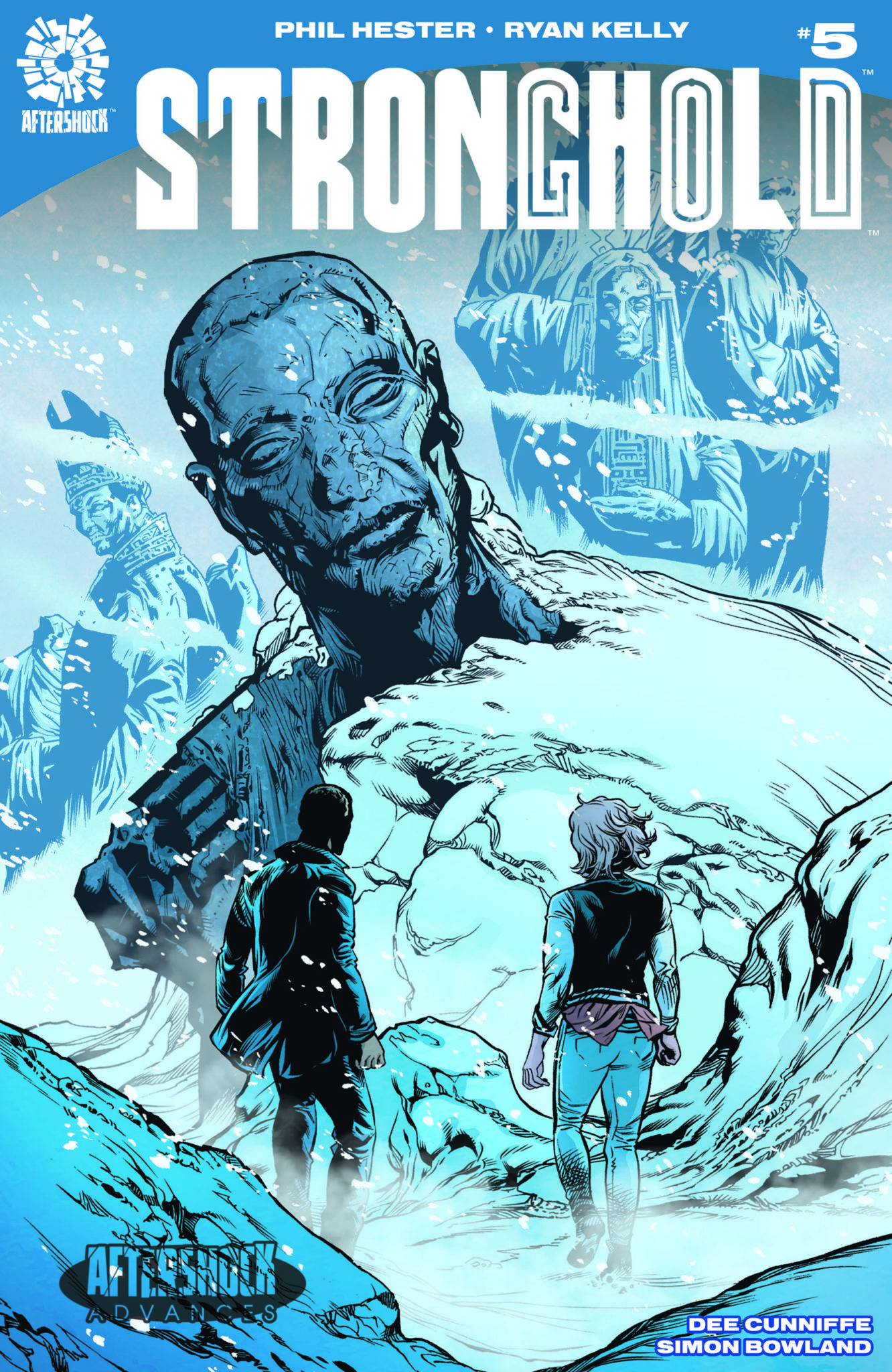This week sees the final issue of Stronghold from AfterShock Comics hitting the shelves and when Gods are woken can anyone survive the unparalleled anger that has been brewing for centuries?
From the very first issue Stronghold has been ambitious and pushed the boat out when it comes to storytelling. The individual creators are all on top form but when they come together they produce something spectacular. Although it may not be selling numbers to equal Marvel or DC comics, Stronghold has the potential to be a significant title in comic book studies. At its heart is a meta-deconstruction of superhero tropes and science fiction clichés.

Gods Of Fiction
In this final issue Phil Hester questions the concept of Gods and aliens. He draws lines between the two and then raises concerns over the blind acceptance of both. Over the previous four issues Hester has built up Michael’s life just to tear it all down again in the finale.
The story moves at a break neck speed in the first half of this issue. Hester brings the major characters together in ‘The Temple’, which is the title for this chapter. Once everyone is in place everything is explained and it’s quite the mind blower: a conspiracy, centuries in the making. In narrative terms it’s like Jonathan Hickman and Alan Moore got together to write a superhero story. Think Miracleman crossed with The Black Monday Murders.
The scale of the story has exploded over the course of the five issues but Hester manages to keep the entire narrative rooted in two characters, Michael and Claire. Their relationship has grown over time and the interaction between them allows the reader to accept the rest of the story. It is also a narrative crutch on which the plot leans. Without the believable characters the story would fall apart.

Myth Building Art
Elements of the Superhero genre are replicated within the pages of Stronghold but they have been subverted to meet the needs of the narrative. Superman’s Fortress of Solitude has been turned into a tomb to bury the history of the Primacy, otherwise known as Michael. The concept of a safe haven for the superhero to escape to has been twisted by Hester and turned into a palace of false worship and disturbing imagery thanks to Ryan Kelly’s artwork.
The reader is introduced to the Temple slowly before a full page spread exposes the vast, empty horror of the Primacy’s past. Kelly keeps the backgrounds obscured in the early pages to make the full reveal more impactful. The sense of wonder and awe is mixed with revulsion and fear in the vast space of rock and petrified Titans. The scale of the Temple reflects the scale of the narrative as the history is unveiled.
The design of Michael’s real self is alien enough to standout against the humans surrounding him but still recognisably Michael. This is achieved through a mix of intricate inking and a contrasting coloring. Dee Cunniffe makes Michael’s form stand out in the panels by giving him an unnatural purple color, free from shades. His appearance represents the alien-ness of his heritage and creates a division between him and the humans, even the augmented humans like the Holdmother.
The division is important for the plot and the visual expression makes it much easier for the reader to accept. In a comic as complex as Stronghold has become it is important to make the storytelling as clear as possible and this is exactly what Kelly and Cunniffe have done.
The final piece to the puzzle is adding the drama. While the script and the art build a lot of the tension and establish character, it is arguably Simon Bowland’s lettering that gives the story it’s pace and, in turn, builds the drama. He splits the speech up and spreads it across multiple panels, like paragraph breaks, giving each idea or phrase its own space to breath. Sometimes he uses connectors to stretch the break and at other times his balloons butt up against each other.
By changing the types of links between balloons Bowland is able to draw out speeches or condense them depending on the narrative weight of the statements. He also keeps the majority of the balloons floating up against the top of the panel boarder. This makes it easier for him to emphasis a particular speech balloon simply by bringing it down, into the panel so that it doesn’t touch any of the boarders.

The End
Stronghold has a complex, multi-layered story and technically wonderful art work. As this is the final issue the story of Michael and Claire inevitably has to come to an end. And it is in the closing pages of this comic where the only complaint can be levelled at it. The whole thing is over too quickly. Hester and Co wrap everything up in the last few pages and it feels too sudden. In some ways it is like an episode of Star Trek: The Next Generation where the plot is neatly wrapped up in the final five minutes.
After the roller-coaster ride of a series the ending comes too soon. It is lacking a final chapter, an aftermath to the story. This would allow the creators to examine other aspects of the Superhero genre while giving the characters and solid send off.
Despite the abrupt ending, everything about Stronghold is expertly produced to create an exciting, multifaceted comic. It can be read on a number of levels and will appeal to a wide range of readers. It is a self-referential science fiction story that takes comic book craft seriously. Anybody who reads comics should be reading this and anybody who studies comics should be studying this.
If you have not read the previous issues it may be too late for you to get into Stronghold but I would recommend, without doubt, to hunt down the trade collection as soon as it is released. You will not be disappointed.

